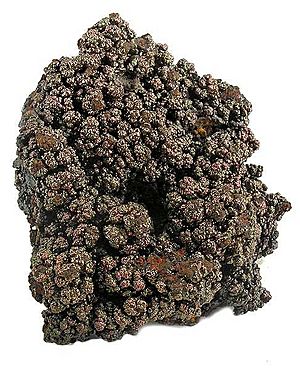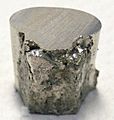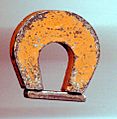Nickel facts for kids
Nickel is a shiny, silver-white metal that is also a chemical element. Its special chemical symbol is Ni. It has an atomic number of 28, which means it has 28 protons in its center. Nickel is known as a transition metal, a group of metals that are often strong and good at conducting electricity.
Contents
What is Nickel Like?
Physical Features of Nickel
Nickel looks like a silver-white metal and can be polished to be very shiny. It is also magnetic, but if you heat it above 355 degrees Celsius (671 degrees Fahrenheit), it loses its magnetism. Unlike some other metals, nickel is not soft. It can be easily stretched into thin wires. Also, it is not radioactive, which means it doesn't give off harmful radiation.
How Nickel Reacts (Chemical Features)
Nickel is not a very reactive metal. It dissolves slowly if you put it in acids. One great thing about nickel is that it doesn't rust like iron does. Instead, it forms a very thin layer of nickel(II) oxide on its surface. This layer acts like a protective shield, stopping more of the metal from getting damaged by air or water. Aluminium does something similar to protect itself.
Nickel's Chemical Compounds
Nickel can be found in two main forms when it combines with other elements: nickel(II) and nickel(III). The nickel(II) form is much more common. When nickel is in its nickel(II) form, its compounds are usually green. For example, Nickel(II) chloride is a common compound in this form and looks greenish.
Nickel(II) oxide is usually dark green, but sometimes it can look gray. This happens when a small amount of nickel is in the nickel(III) form. Nickel(III) compounds are also often grayish and can act as oxidizing agents, which means they can take electrons from other substances. Overall, nickel compounds can be green, blue, gray, or even black.
- Nickel(II) Compounds
These compounds are not super reactive and are usually green or blue. They can be harmful if you touch them, as they might irritate your skin. Some of them are even known to cause cancer (these are called carcinogens).
- Nickel(II) carbonate (green)
- Nickel(II) chloride (greenish)
- Nickel(II) hydroxide (light green)
- Nickel(II) nitrate (greenish)
- Nickel(II) oxide (gray or light green)
- Nickel(II) sulfate (blue-green)
- Nickel(III) Compounds
These compounds are typically black or gray.
Nickel's Different Forms (Isotopes)
Isotopes are different versions of the same element. They have the same number of protons but different numbers of neutrons. Nickel has many isotopes, ranging in weight from 48Ni to 78Ni.
In nature, you can find five stable isotopes of nickel: 58Ni, 60Ni, 61Ni, 62Ni, and 64Ni. Scientists have also found at least 26 radioactive isotopes of nickel. These are isotopes that are not stable and slowly change over time.
How Nickel Was Discovered
Nickel was first found because people were confused! They had an ore (a rock with metal in it) that looked like it should contain copper, but when they tried to get copper from it, they couldn't.
Later, in 1751, a scientist named Axel Fredrik Cronstedt figured out that this ore actually contained a brand new metal. He was the one who isolated nickel as a metal and officially named it a chemical element. At first, the only way to get nickel was from this special copper-like ore. Over time, it was also produced as a side product when making cobalt blue dye.
Where is Nickel Found?
You usually don't find pure nickel metal lying around in the ground. Instead, it's typically mixed with other substances in minerals. However, sometimes meteorites (rocks from space) can contain both nickel and iron metal.
The most common mineral that contains nickel is called pentlandite. Scientists believe that most of the nickel on Earth is actually deep inside our planet, in the outer and inner cores.
Nickel ores are found in two main types: sulfidic ores and lateritic ores. The Philippines is the country that mines the most nickel. Other big nickel mining countries include Russia, Canada, and Australia.
How is Nickel Prepared for Use?
Nickel is found in both laterite and sulfide ores. To get the nickel out, these ores are heated until they melt, which helps to concentrate the nickel. They can also be separated using oils.
Pure nickel is made from its sulfide by heating it in the air. This process, called oxidation, turns the sulfide into sulfur dioxide gas, leaving behind liquid nickel. This nickel isn't perfectly pure yet, so it needs more work.
To get very pure nickel (more than 99% pure), an electrolytic process is used. In this method, the nickel is dissolved in a bath of sulfuric acid. When electricity is passed through the bath, the pure nickel sticks to special plates called cathodes. Any impurities stay in the acid or sink to the bottom. These impurities can sometimes contain valuable precious metals!
What is Nickel Used For?
A large amount of the nickel produced, about 68%, is used to make stainless steel. This is a type of steel that doesn't rust easily. Nickel is also used in other important alloys (mixtures of metals), like nichrome, which is a mix of nickel and chromium. Nichrome is often used in heating elements because it can get very hot without melting.
Nickel is also used to make magnets, including special, expensive alloys called superalloys that are used in things like jet engines.
You'll find nickel in rechargeable batteries. For example, a lithium-ion battery can have up to 15% nickel, and nickel-cadmium batteries also use it. Nickel compounds are used to electroplate other items, which means putting a thin layer of nickel on their surface to make them look shiny or protect them.
Nickel and some of its compounds can also act as a catalyst, which is something that speeds up a chemical reaction without being used up itself. Besides stainless steel, nickel is used in other nonferrous alloys (alloys that don't contain much iron).
Nickel is used in many everyday products like alnico magnets, coinage, electric guitar strings, microphone capsules, and shiny plumbing fixtures. It can even give a green tint to glass.
Special nickel foam is used in gas diffusion electrodes for alkaline fuel cells, which are devices that create electricity. Nickel and its alloys are also used as catalysts for reactions that add hydrogen to substances, like making margarine from unsaturated oils.
Nickel in Ocean Water
Nickel is found in the surface waters of the world's oceans. Its amounts can change depending on the area. Often, where there are more nutrients in the water, there is also more nickel. This is because tiny ocean plants, like diatoms, use nickel when they make their own food through photosynthesis. When these organisms die and sink, the nickel is released back into the deeper water.
Generally, the amount of dissolved nickel in seawater is rarely below 1.5-2.0 units (nanomols per kilogram of seawater). In areas where there are fewer nutrients, like some parts of the northern Atlantic Ocean, nickel levels can be lower. This might be because certain organisms that fix nitrogen use more nickel, or because of dust blown from land that contains iron.
In areas with lots of nutrients, like the eastern parts of oceans where deep water rises to the surface, nickel levels can be higher. For example, in the North Atlantic, nickel levels tend to increase as you go deeper into the ocean. In the Southern Ocean and the northeast Pacific Ocean, nickel levels are generally higher. This is often due to strong mixing of the water or areas with high plant growth.
Safety Tips for Nickel
Nickel can sometimes irritate your skin. This is why some people find that jewelry containing nickel can cause a rash or itchiness. Some nickel salts are known to be carcinogens, meaning they can cause cancer. While nickel is not as harmful as some other metals like mercury, it is still considered toxic and should be handled with care.
Related pages
- Nickel compounds
| Periodic table | |||||||||||||||||||||||||||||||||||||||||
|---|---|---|---|---|---|---|---|---|---|---|---|---|---|---|---|---|---|---|---|---|---|---|---|---|---|---|---|---|---|---|---|---|---|---|---|---|---|---|---|---|---|
| H | He | ||||||||||||||||||||||||||||||||||||||||
| Li | Be | B | C | N | O | F | Ne | ||||||||||||||||||||||||||||||||||
| Na | Mg | Al | Si | P | S | Cl | Ar | ||||||||||||||||||||||||||||||||||
| K | Ca | Sc | Ti | V | Cr | Mn | Fe | Co | Ni | Cu | Zn | Ga | Ge | As | Se | Br | Kr | ||||||||||||||||||||||||
| Rb | Sr | Y | Zr | Nb | Mo | Tc | Ru | Rh | Pd | Ag | Cd | In | Sn | Sb | Te | I | Xe | ||||||||||||||||||||||||
| Cs | Ba | La | Ce | Pr | Nd | Pm | Sm | Eu | Gd | Tb | Dy | Ho | Er | Tm | Yb | Lu | Hf | Ta | W | Re | Os | Ir | Pt | Au | Hg | Tl | Pb | Bi | Po | At | Rn | ||||||||||
| Fr | Ra | Ac | Th | Pa | U | Np | Pu | Am | Cm | Bk | Cf | Es | Fm | Md | No | Lr | Rf | Db | Sg | Bh | Hs | Mt | Ds | Rg | Cn | Uut | Fl | Uup | Lv | Uus | Uuo | ||||||||||
|
|||||||||||||||||||||||||||||||||||||||||
Images for kids
-
Electron micrograph of a Ni nanocrystal inside a single wall carbon nanotube; scale bar 5 nm.
-
Electrolytically refined nickel nodule, with green, crystallized nickel-electrolyte salts visible in the pores.
-
A "horseshoe magnet" made of alnico nickel alloy.
See also
 In Spanish: Níquel para niños
In Spanish: Níquel para niños

















